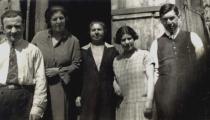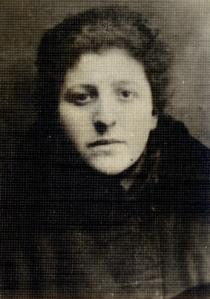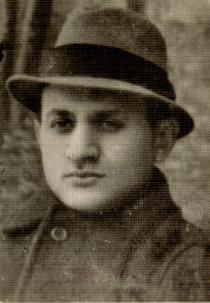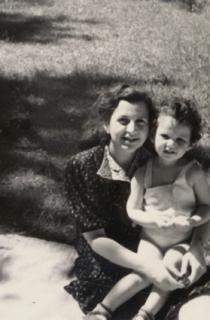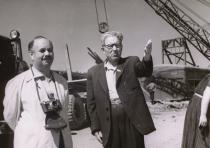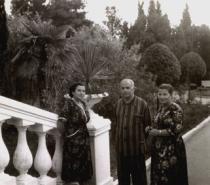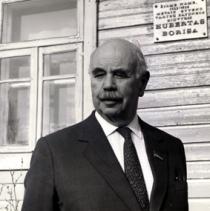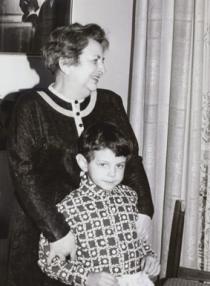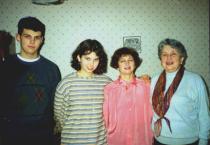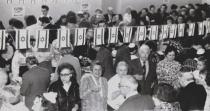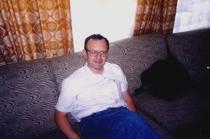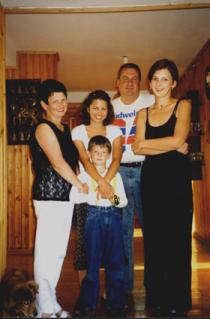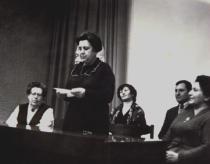
Frida Zimanene
Vilnius
Lithuania
Interviewer: Zhanna Litinskaya
Date of interview: February 2005
I met Frida Zimanene in the Vilnius Jewish community. Frida is a very pretty woman. Her elegant outfit and neat hairdo speak for the fact that she is still taking care of herself. Frida helped me find people who were ready for an interview. She didn’t even mention the fact that she had any prewar pictures herself. As it turned out, she had concealed her age. I couldn’t guess how old she was. I promised Frida not to еxpose her age. She looks much younger than she actually is. I had a meeting with Frida in her wonderful newly-renovated three-room apartment. The rooms are light and well-furnished. There are beautiful pictures and books. The hostess asked me to sit at a coffee table. She treated me to coffee and pastries before we started the interview. She is very optimistic, merry and good-humored.
The Soviet invasion of the Baltics
My family background
My name is Frida Zimanene. My maiden name is Shevalovichuyte. I was born in Kaunas in the early 1920s. The thing is that during the wartime there was a mix-up with the documents, so I became ‘younger.’ According to my passport I was born on 23rd February 1924. In reality, I am several years older but I’d prefer not to mention my age.
Unfortunately, I know hardly anything about my ancestors. When I was young, I found it interesting to ask my parents questions in connection with our family history, but after the war my father was the only grown-up in my family who survived, and he avoided talking about the past as it was hard on him. Besides, being of a certain age now I can’t keep a lot of things in my memory and I can’t recall many names and dates. Nevertheless, I would like to tell you about my kin and to preserve their memory. The only grandparent I knew was my paternal grandmother, Chaya Shevalovich. She was born in Kaunas in the 1870s. She got married and took care of the children and household like all Jewish women. I don’t know what my paternal grandfather Chaim did for a living. He was also born in the 1870s, but he died long before I was born, without even reaching the age of 50. During the Great Patriotic War 1 Grandmother Chaya stayed in the occupation with my parents. She perished in the Kaunas ghetto 2.
Father had a sister, who was born in the early 1890s. She was older than my father by two or three years. Her name was Sheina. I forgot the name of my aunt’s husband. Sheina and her family lived in Kaunas not far from us. Her husband died long before the outbreak of the Great Patriotic War. I don’t remember him. Sheina had four children – two daughters and two sons. Unfortunately, I don’t remember their names. Her elder daughter left for Paris in the 1930s after getting married. Her wedding was with a chuppah, rabbi and klezmer music. A lot of guests were invited for the wedding party, which took place in our house. Sheina’s sons were sportsmen. They did track-and-field athletics. Her sons were members of Maccabi 3, and often went for competitions to different cities and countries.
During the war, Sheina, her sons and younger daughter, who had turned about ten years old, happened to be in the Kaunas ghetto. The guys were executed during the first big action. Sheina’s daughter also perished. Sheina, exhausted and aged, survived the ghetto, but at the end of the war she was sent to one of the fascist concentration camps in the north of Estonia. Before the Soviet Army came, women were taken on a barge to the Northern Sea and drowned there. Almost all the women perished, but Sheina was rescued by some fisherman. I don’t know the details of that story. Sheina didn’t want to be asked about her horrible war years.
Upon her return, Aunt Sheina moved in with us, and then my husband made arrangements for her to be given a one-room apartment in the adjacent house. We didn’t look for her elder daughter as my husband had a very high state position and couldn’t risk it. At that time any type of relation with the capitalist world could negatively affect his career 4. Sheina died in the early 1960s in Kaunas. She was buried in the Jewish sector of the town cemetery 5.
Now I would like to find Sheina’s daughter, but I know neither her name nor her surname. About two years ago the cemetery worker told me that two women had come up to Sheinas’ grave. They definitely looked like foreigners. They discussed something in some foreign language. He knew for sure that it wasn’t English, and he had no idea what language they were speaking. At that time the cemetery worker didn’t think of talking to those ladies, or at least informing me of their visit. I think one of them must have been my cousin, Sheina’s daughter.
My father, Zalman Shevalovich, was born in Kaunas in 1896. There was a tradition in the family of Grandfather Chaim to give children a Jewish education. My father went to cheder, then he finished a couple of grades of a Jewish school. Since his childhood he had been an apprentice of a tailor. I assume that Grandfather Chaim was also a tailor. My father was not just a tailor. He became a true designer. He was the best at making children’s clothes. My parents got married in 1920. They didn’t have a pre-arranged marriage, like most Jews at the time. They met in some company of friends and fell in love with each other.
I don’t know anything about my maternal grandparents. They passed away long before I was born. The only thing I know is that my mother’s maiden name was Michel. My mother had a sister. She was about five years younger than she. Her name was Rosa. She married a Jew called Katzеnis. Rosa was a very beautiful, stately woman. She lived in Kaunas with her husband and two sons. Unfortunately, I don’t remember the names of her husband and children. Rosa and her family also were prisoners of the Kaunas ghetto. Her husband died first. Rosa and her sons perished in 1943 during the liquidation of the ghetto.
Growing up
My mother, Beila Michel, was born in Kaunas in 1898. She finished a couple of grades of school, and knew how to read and write. My mother was brought up with a love for reading. Both her and my father’s parents, simple craftsmen, were more worried about daily bread and earnings. My parents were wed in accordance with all the Jewish traditions– under a chuppah. Their marriage certificate was issued by a rabbi. I was born on 23rd February 1924. I, the first-born, was named Frida. Two years later my mother gave birth to a girl, Paya. In 1932, when my sister and I had grown up a little bit, my mother was expecting another child. She and my father wanted a boy, but wonderful and beautiful twin-girls were born – Chaya and Iyegudis.
We lived in a good rented apartment on Luksho Street. That house belonged to a Jew. His last name was Katz. The owner was an elderly man, and he looked old to me. Katz was very rich. He owned a couple of houses and leased them. I don’t remember his wife, but I recall that Katz’s daughter used to go skiing to Switzerland every year, and that was very prestigious. My sisters and I enviously watched her driving to the house in a cab, dressed up in a nice fur coat.
Our apartment was in a large three-storied brick building. We lived on the first floor. Our apartment wasn’t very big; it consisted of three or four rooms and a kitchen. There was a small hall. The first room was occupied by the store. It was my mother’s business. She stayed behind the counter all day long. Haberdashery goods were sold in that store. There were such primary goods as soap, threads, combs and articles for children. Mother had a large logbook, where debts were entered. As a rule, neighbors bought the goods on credit and paid for them as soon as they had a chance. She was never deceived by any of them.
The biggest room was used as a drawing and dining room. There was a big round table there. Our whole family got together there for dinner and supper. There was also a cupboard. Father used to work in that room as well. The dining table was turned into his working place, where he cut the fabric. Father made pretty good outfits. He made garments for men and women. He didn’t charge much for his work and almost all dwellers of our and adjacent streets were his clients. Besides, my father made coats for children and sold them. He created the designs himself and his articles turned out to be very beautiful. The coats for boys were blue and for girls – pink with pompons. Those coats were sold in my mother’s store.
My father was a very tall and handsome man. He had a good sense of humor. Sometimes, he went for a walk downtown and people who knew me took him for my boyfriend, that’s how young he looked.
Our furniture was rather simple, made of wood, without any ornament, but it was well-made. It seemed to be built to last for centuries. Our drawing-room was multifunctional – it was not only a dining-room and a study, but it also served as my parents’ bedroom. The children’s room was after the drawing-room. Paya and I lived there. When the twins were born, I took the room, previously occupied by Grandmother Chaya. She mostly stayed in her room. She didn’t even join us for lunch. The food was brought to her room. Grandmother took the room of the maid. It was a poky room, partitioned off from the kitchen. Before she got married our maid, a Lithuanian girl called Marite Saviskene, lived in that room.
Marite helped my mother about the house, cooked, bought food products and did the laundry. When she got married, she was still working for us, but she went home at night. Marite always had a lot of work to do. Our food was cooked in the stove, stoked with firewood. So, first firewood had to be brought, cut and then the stove was stoked. Later primuses [Primus stoves] and kerosene stoves appeared. The stove was used as a table. Marite ran the house. My mother had neither the time nor the desire to do house chores. Firstly, she was busy with the store, secondly, there was no tradition in our family to get together for lunch. Everybody had meals when they wanted to, and the food was always served by Marite. She was fluent in Yiddish, as it was spoken in our house. Besides, Marite cooked great Jewish dishes.
My parents weren’t religious. I can’t remember if my mother lit the candles on Friday. Probably, Grandmother Chaya lit candles in her little room, but I don’t remember it for sure. My parents belonged to the lower middle class, and thought only of their daily bread. Our family had a rather modest living. On Saturday the store was closed, as Jews weren’t supposed to do anything on that day and on Sunday all stores were closed in accordance with the Lithuanian law. Mother didn’t like weekends as she earned nothing. However, when some of her clients needed something, my mother opened the door to the store, from one of our rooms in the house, and sold the things to the customer, asking him not to tell anybody about that.
We didn’t observe the kashrut either. I don’t remember anybody going to a shochet to have the poultry slaughtered. The meat was bought at the market. I don’t think there were separate dishes for meat and dairy products. However, we didn’t eat pork. Mother at least made it look like we observed the kashrut. On Sabbath my mother went to the synagogue not because she was religious, but because of the custom. We were surrounded by Jews who stuck to traditions. They would have found it strange, if not worse, if our family had openly neglected traditions. My mother asked my father persistently to go to the synagogue. He put a kippah on and went there. It was a real ordeal for him as he didn’t feel like going there. My parents went to the synagogue not far from our house. It was the synagogue of the tailors. Sometimes, on Sabbath my father rushed home from the synagogue. He would wink at me, open the cupboard, gulp down a shot of vodka and go back to the synagogue happily patting his belly. Father said that it was hard for him to stay in the synagogue without vodka and listen to long monotonous prayers.
On Friday Marite cooked a Sabbath meal and my mother instructed her. I don’t remember for sure what kind of dishes we had on Saturdays. Usually those were dishes that we didn’t have to heat, such as tsimes, gefilte fish once in while. The mandatory dish was chulent. Marite was a master of that dish. It consisted of meat, potatoes and beans. The warm pot with chulent was taken to the neighboring bakery as the oven was still warm after baking challot. There was a sign on our pot – Shevalovich – as other neighbors brought their chulent to the bakery too. On Saturday my parents took our pot on the way from the synagogue. When my parents came home, we started our Sabbath meal. I don’t think Marite cooked on Saturday as the main dish was chulent. After lunch we went to bed, as the Sabbath nap was also traditional in our family.
In spite of the fact that my parents weren’t truly religious, some Jewish holidays were celebrated in our family in accordance with the tradition. I can’t recall, if my parents fasted on Yom Kippur. As far as I remember, my father was against it, but Mother fasted. On that day as well as on Rosh Hashanah we didn’t have a festive meal. I don’t remember the fall holidays. At any rate a sukkah wasn’t set up in our yard. I remember the joyful holiday of Simchat Torah as we, the children, went to the synagogue not far from the house. We saw a procession of religious Jews, walking with the Torah scroll around the synagogue.
We didn’t mark Chanukkah at home, and we weren’t told about the origin of this holiday. I learnt about it, when I went to school. Every day my mother lit a new candle in a splendid silver chanukkiyah, placed on the windowsill. In that period of time candles were lit in Jewish houses. There were so many of them, that Kaunas appeared to be inhabited mostly by Jews. Marite cooked potato fritters and tasty mushroom and vegetable sauces to go with them. Of course, we got Chanukkah gelt from our parents. We were agog to get it. Marite made us happy with hamantashen. She baked them as good as any other Jewish lady. I don’t recall bringing shelakhmones to each other. I learnt about that tradition, when I studied at the Jewish school.
I remember Pesach best of all. People got ready for that holiday beforehand. Linen, carpets, featherbeds were taken out, dusted and dried. There was a thorough cleaning in the house: the furniture was polished, the floors were waxed, curtains and tablecloths were washed and ironed. Everything was sparkling and looked spic-and-span. Father made new things for all the children beforehand. On Pesach we put on the new dresses. Mother bought us new shoes for Pesach. The eve of the holiday was the most pleasing event for me, especially when festive dishes were taken out from the chest. The set was gorgeous, consisting of a silver wine set, silver goblets, silverware and splendid china. Everyday dishes were packed up and taken to the loft. On Pascal holidays festive dishes were the adornment of the table. Matzah was brought from the synagogue in a large hamper, covered with a white napkin. There should be no bread during the Paschal period. I cannot recall my parents carrying out the rite of banishing chametz. Our seder was an ordinary festive dinner. We didn’t look for the afikoman and didn’t ask Father questions about the origin of the holiday. I found out about those traditions at school.
My parents had a tough choice of which school I should attend. There were several Jewish educational institutions in Kaunas, as a lot of Jews lived there. Those were: the Hebrew lyceum Shvabes, the Yiddish Realschule 6, the Lithuanian Jewish lyceum and a religious Jewish school. At that time my parents didn’t even want to hear about the latter. The Jewish Commercial Lyceum was the most democratic and popular with the middle class Jews, which my parents also belonged to. I went to that lyceum, when I turned seven.
I was lucky to spend my school time in that wonderful lyceum. A true spirit of friendship reigned in our lyceum, which was later renamed after Sholem Aleichem 7. Our teachers put their heart and soul into their work, they were true masters, fond of their profession. At times there was a demand for teachers, as there were backlogs in salary payments, since the lyceum worked on the tuition fees paid by the students. But still, none of the teachers ever cancelled a class on the ground of backlogged salary. We always had our classes. I don’t know what amount was paid for me, and later for my sister Paya. All I know is that it wasn’t cheap. Mostly children of well-off Jews – doctors, lawyers, entrepreneurs – studied there. There were also children of middle-classed parents, like my sister and I. Gifted children from the poorer strata of society were also admitted to the lyceum. Their tuition was paid by a special committee, a charity fund.
The headmaster of our lyceum, Livin, managed to create great working conditions for both teachers and students. His wife also worked for the lyceum. Unfortunately, both of them perished in Kaunas ghetto. All subjects were taught in Yiddish. Besides, there were a lot of hours in our syllabus devoted to the study of the Lithuanian language. Our Lithuanian teacher Zimanis, the youngest among his colleagues, was loved by everybody. He was a talented teacher, who plied us with love for the Lithuanian language. Besides, Zimanis taught Biology. He knew our country very well. In the summer he arranged hiking trips around Lithuania, as well as kayaking along the rivers and lakes of our country. During such trips the teacher taught the children unobtrusively. Sometimes a herb could be the subject of a whole story.
Besides Lithuanian, we studied German and English. I was good at languages and thanks to the lyceum I got solid knowledge. I didn’t study languages anywhere else. We didn’t just study modern languages. We also studied Latin. I liked liberal arts very much. My favorite teacher was Esther Berger. She taught literature. We studied the classics of Jewish literature. We also studied religion at school, but the class, where Tannakh was read, was a mere formality. At that time we weren’t interested in the Jewish religion. We kept abreast with the modern times.
Our school paid much attention to extra-curricular activities. There were all kinds of clubs – drama, mathematics, biology, choir chamber music. I liked the drama club a lot. Here the works by Sholem Aleichem were staged. I tried attending that club, but soon I understood that I couldn’t go on the stage. I was very shy. Then I was enrolled in a language studies club. I didn’t get straight excellent marks, but I did pretty well.
There was a students’ council at school. There it was decided that every student who was lagging behind was supposed to be helped with homework by a good student. I was assigned to Minka Filkenstein. Her parents were rather elderly and well-heeled. Minka didn’t want to study. I came to see her every day. At first, I tried making my friend study, but it was next to impossible. Minka had boyfriends who climbed into her apartment on the fire escape route. Minka’s parents were sure that we were studying, but in fact we were flirting with the boys. Besides, Minka smoked and she taught me smoking in the end. It turned out that I, the teacher, was in the leading strings of my student. In general, there was no use in our classes.
At that time there was a great number of youth organizations in Kaunas. There were also Zionist organizations – Maccabi, Betar 8. There were also ‘left-wing’ movements in our school and some teachers, including Zimanis, strove to attract students to underground Komsomol organizations 9. Many of my comrades joined the Komsomol. They got together surreptitiously, handed out flyers. They were also involved in Communist propaganda. I was totally apolitical. Our family wasn’t interested in politics at all.
I took an interest in things that appealed to young ladies – dancing and flirting. In the evening we strolled along the streets of Kaunas, ate ice-cream, went to the cinemas and cafes. There were all kinds of movies on, most of them were German. I loved comedies. There were a lot of stores downtown. Most of them were Jewish. We liked to drop in a Jewish jewelry store, or the footwear store Batya. Almost every night we went out to our favorite café, Monika. It was also located in the downtown area. Here we enjoyed pastries, coffee. There were modern dances such as tango, rumba, Charleston. Paya also went there with me. I loved my sister very much. In spite of being a couple of years younger than me she was very sociable and funny.
In the summer we went to our dacha 10. The thing is that my father had asthma and doctors recommended him to live in the suburb. My parents bought a small plot of land, about 30 kilometers away from the town. It was near the river Neman. There they had a small wooden house built and we went there on a steamboat in summertime. My younger sisters liked the dacha the most. They were wonderful girls – pretty and smart. Paya and I often took care of the girls, when our parents were busy. We didn’t have our dacha for a long time. It was hard on my father to keep an apartment in Kaunas and a country house, therefore my parents sold the plot of land and the house.
In spite of the fact that my parents weren’t interested in politics, they knew what was going on. Father subscribed to the Jewish newspaper Folksblat – Jewish flyer. That paper as well as other mass media wrote about Hitler, about Fascists coming to power in Germany. In 1933 all Jewish children left the Kaunas German lyceum after a Fascist putsch. Strange as it may be, my mother, who was apolitical more than any other members of our family, felt the imminent danger coming from Hitler. She reiterated that a calamity was about to happen and we had to be ready for it. When I finished the lyceum in 1938, she decided that I should stay at home, to be closer to her. Mother always dreamt that I should obtain an education in Economics and start helping her with the store and expand her business. I stayed at home for a year after finishing the lyceum. In 1939 I decided to enter university. When Vilnius was annexed to Lithuania 11, it became its capital again. Kaunas University was transferred to Vilnius, and my mother was flatly against my going to Vilnius. I had to obey. I was always obedient to my parents.
I was enrolled for typing courses in order to get any profession. Father bought me a typing machine and I acquired good touch typing skills. When the Soviets came to power 12 in 1940, I didn’t have a job. Many people were happy to see the Soviet Army 13. Our family also welcomed them as a hope for a better future. There was no other option for a small Lithuania – either Hitler, or Stalin. When the soldiers were marching along Kaunas, I and the governess from a Jewish kindergarten, who accidentally happened to be close by, were in the welcoming crowd. She admiringly spoke of the bright future for the Jews in the Soviet Union, and I involuntarily caught her joyful mood and inspiration.
At first, there were hardly any changes. Mother’s store was so small that her business was of no interest to the new regime. However, it was nationalized a couple of months later and my mother started working there as a sales assistant. Father kept on working. He got even more orders as Soviet officers with their wives and children settled in Kaunas. The wives of officers, who hadn’t seen beautiful clothes before, swept anything they liked in the store and ordered new things for their kids. Mother leased one of our rooms to a yeshivah student. That student was very poor and our kind Marite gave him food in our kitchen. I was astounded that the student was so untidy, even filthy. It was strange to watch how a person who had been praying all day long used one and the same towel all year round and went without a bath for weeks. I mention that student, whose name I forgot, as there was a very sad episode in our family connected with him.
The Soviet invasion of the Baltics
A couple of weeks after the Soviets came to power, my lyceum fellows from the Communist underground called on me. They were assigned to different positions in Komsomol organizations once the Soviets were in power. They suggested that I should do typing for them as my Lithuanian was very good. I had never been paid for my work yet. I had worked for a couple of weeks and was employed by the municipal Komsomol committee of Kaunas. First, I was a typist, and I was consequently promoted to the head of the office. Soon I joined the Komsomol, otherwise I wouldn’t have been able to work for the municipal committee.
During the war
On 22nd June 1941, when the Great Patriotic War broke out, some people came to me from work. I had to destroy all Komsomol documents for the enemy not to see them. We burnt those documents in the central heating boiler in the basement premises of the municipal committee. There was no panic. We understood that Komsomol members would become the first victims of Fascists, in the event the city was occupied. The leaders of the municipal committee arranged bus transportation and ordered us to leave the town for a couple of days. We were told that we should get to Shvenchas, located in the Western part of Lithuania and stay there for five days. Meanwhile, the Red Army would shatter the Fascists and then we would come back home. I came home with the news and told my parents that I would be leaving for several days. We didn’t even think of saying good-bye as we were sure we would see each other again soon. I kissed my sisters Chaya and Iyegudis. Paya was not in. I took some money, documents, underwear and without changing my silk dress darted to the municipal committee.
We hit the road. In a couple of hours I understood that we would not come back as soon as we had thought. There was a terrible war, and the army was retreating. There were a lot of fugitives: on carts, trolleys, bicycles or on foot. The column of peaceful civilians was bombed by Fascist aircrafts. I saw death for the first time in my life. It was comparatively quiet in Minsk [today capital of Belarus]. We got off the bus and went to the market to get food. Our company drew the attention of the people around, as we looked differently. All of us were very well dressed, unlike the Soviet people. We were detained by a patrol right in the street. The whole group was arrested by NKVD officers 14. They were pressed for time and since we definitely looked like capitalists we were charged with espionage.
The wife of the first secretary of the central Komsomol committee of Lithuania was with us. Unfortunately, I don’t remember her name. She managed to get an appointment with the authorities. This lady, who had been imprisoned in bourgeois Lithuania for her Communist beliefs, convinced the authorities that we were not spies and we were released. She also managed to make arrangements for our bus to be returned to us as it had already been requisitioned. Minsk was bombed. There were corpses lying outside. It was impossible to get on the train. We took the bus and headed on. We often stopped in the villages, stayed in the houses. Simple Belarusian peasants were kind and hospitable. They had us sit down at the table and share the potluck with them. Most of them were very poor. They didn’t have anything but potatoes, young onion and milk. At any rate, we had a place to stay and something to eat. In Russia we got off the bus and took a train, crammed with fugitives. It took us a week to get to the town of Penza [about 600 km from Moscow]. There we went to the evacuation point, wherefrom we were sent to the small town of Nikolo-Pestrovka, not far from Penza.
A new life began. It differed from the prewar times. We were housed in some place. I lived in one through room with two girls. We slept on a big stove bench 15. We were lucky, as in cold times we were even warm. There was a glass-works in Nikolo-Pestrovka. It was remade into a military plant. We, tender girls, who hadn’t known physical labor before, had to work at the mill. We were given jerseys, padded jackets, quilted pants and we took to work. There was a patriotic spirit in the air and all of us were willing to assist the front. We would work all day long. At times we had to work night shifts.
At first, it was very hard as we didn’t have any things, no bed-linen, and no underwear. Our secretary Belyaukas, who had taken Komsomol aid money with him, gave everybody their equal share. We, the girls, took that money and spent it on unbleached calico and had night gowns made as we weren’t used to sleeping in the clothes we wore. In a couple of days we were invited for a dancing party at the kolkhoz club 16, which was out of town. We didn’t have anything to put on, and decided to wear our night gowns, just putting belts over them. It turned out that we had the best outfits at the dancing party.
In general, being young and optimistic helped us survive. I was missing my parents and had no idea what was going on, on the occupied territory. In November 1941, there was a pleasant surprise. My Paya was waiting for me to come back from work. She also left Kaunas with somebody. She lived for a couple of month in Kirov oblast [today Russia]. Paya found me via people we knew and came to my home without preliminary notice. Our joy was boundless. Finally, my sister was with me. Paya decided to work for the kolkhoz as she heard it was easier with the food there. First, I sent her money, before my sister got used to hard labor, as I didn’t want her to starve. Then she started getting trudodni 17, and helping me.
We had a hard life, like all evacuees. The bread ration was not enough 18. There were times, when I got bread and ate it all on my way home. Our landlady, who had a pretty good husbandry, was very stingy. She had no compassion at all. She dried bread in the loft for her husband and son who were to be drafted into the army. We made a hole there and snitched rusks without any twinges of remorse.
In spring 1942, Paya went to the army as a volunteer, when she found out about the Lithuanian division 19. She went to Balakhna, where the division was being formed and started writing me from there about front-line fraternity and the sacred duty of every citizen to defend one’s country. I also had a patriotic spirit and in 1942 I joined the Communist Party thinking of being drafted into the army. Things turned out in a different way.
I had stayed in Nikolo-Pestrovka until spring 1943. First, the representative government of the Lithuanian republic was in Kazan. Then it was relocated to Moscow 20. My Komsomol comrades were looking for me. When they found me, I was invited to work in Moscow. I was deeply impressed by the city. In spite of the wartime and blocked windows of the houses and things being diffident in the peace times, I admired that huge beautiful city. The representative office and other Lithuanian institutions were on Vorovskiy Street. I felt myself much closer to my motherland, when I got there. I was hired as a typist by the central Komsomol committee of Lithuania. We settled in the hostel of the representative office, which was right by its premises.
There was a center under the auspice of the representative office, where the people from Lithuania got together. Lithuanian writers, poets, actors etc. who happened to be in evacuation, were sticking together. We dreamt of the victory and of our return to our native Lithuania. We were young! Theaters were reorganized in Moscow an there was a chance to get a ticket via our representative office. My friends and I attended performances of different theaters. Of course, we were not saturated in this war-time Moscow, but at least we weren’t starving like in Nikolo-Pestrovks. It was cold, but we felt warm with the idea that the Soviet Army would definitely win. We knew nothing about our relatives in occupation. Of course, we heard the stories about the atrocities on the occupied territories. For some reason I hoped for a miracle, to see my kin upon my return to Lithuania.
Shortly after I came to Moscow, I met my lyceum teacher Genrich Osherovich Zimanis. Genrich was born in Kaunas in 1914. He came from a common Jewish family. He was an only child. In the 1930s, upon graduation from Kaunas University Genrich taught literature at a Lithuanian lyceum. Genrich’s father died before the outbreak of war. Genrich made arrangements for his mother Olga to leave Kaunas in a car. On her way, she was shot by Lithuanians, who were serving the Germans. Genrich became a Communist right after the Soviets came to Lithuania. He was involved in ideology. Now he was one of the secretaries of the Central Committee. In spite of a big disparity in years we had a crush on each other. In war times people learnt how to value their feelings. We didn’t date for a long time. In a couple of weeks Genrich and I were like a husband and wife. We started living together. We loved each other very much and spent a couple of happy weeks together.
In spring 1943 Genrich was sent to Lithuania on an assignment to organize a partisan movement. It turned out that the aircraft heading for Lithuania with their group had an accident. A lot of people perished. Genrich was also severely wounded. He decided not to return to the rear, Genrich kept to bed in a dug-out for a couple of weeks and went through phytotherapy. Nobody revealed the truth to me, and I thought that the landing was successful. Sometimes, I got skimpy messages from Genrich and knew that he was alive and looking forward to meeting me. Vilnius was liberated on 13th July 1944 and Genrich took an active part in the liberation of the city. Upon liberation he invited me to Lithuania and I went there right away.
Genrich worked at the Central Committee of the Communist Party of Lithuania. He welcomed me very warmly when I arrived. There were a lot of unoccupied apartments in Vilnius and we were given a large apartment on Palangus Street. We loved each other very much and didn’t haste in registering our marriage. We lived together without getting married. Right upon my arrival I went to Kaunas, hoping to find the trace of my kin. I found Marite. I talked to her for several hours. She told me that my parents, Grandmother Chaya and sisters had stayed in the occupation. When Kaunas was occupied, actions against Communists commenced immediately. A Lithuanian man, who was working for Fascists, came in and started asking who were Communists and Komsomol members. Then that nice Jew, the yeshivah student, who rented a room in our apartment, said that Chayele and Iyegudis were pioneers 21 and wore red scarves. However, the Fascist wasn’t interested in children.
Later they happened to be in the ghetto. Before moving there, Mother gave Marite her sewing-machine and some precious things, vases and statuettes. Loyal Marite always exchanged them for products, went to the ghetto gates and gave food to my mother. She was sorry for my sisters, but she was afraid to take them in as her neighbor was an ardent anti-Semite and Marite understood that she would give them away. Grandmother Chaya perished during the first action and my mother and the girls stayed alive until the liquidation of the ghetto. Her sister Rosa Katzеne was also with her. On the day of the liquidation of the ghetto they bribed the security by the gate, gave him all the things brought by Marite, and he let them out of the gate. My mother’s legs were hurting. She couldn’t walk and squatted not far from the gate. Rosa tried to give her a hand. Then the policeman, who had just accepted the bribe, fired at them from the gun. Thus, my mother and aunt perished.
I still don’t know what happened to my sisters. I had been looking for them, going from one orphanage to another, asking witnesses. There was no trace of Chaya and Iyegudis. They most likely perished with my mother. The only thing I knew about Father at that time was that in 1943 he was sent to a concentration camp from the ghetto.
My sister Paya was the only one from my kin who was close to me. She served in the Lithuanian division as a radio operator. Then she was demobilized and settled in Vilnius. She married a local Jew, Mark, unfortunately I forgot his surname. Paya kept her maiden name. Her husband’s family was deported to Siberia in 1940 22. Mark managed to get a university education, he became an actor. Paya had a daughter, named after our mother Bella. Paya and I were very close.
In 1945 I gave birth to a son and named him Alexander. In a year when our baby started walking, Genrich and I registered our marriage. We didn’t have a wedding party. It would have looked ridiculous since we had lived together for such a long time.
In late 1945 our family had reason to rejoice: my father returned. He managed to survive in one of the most terrible Fascist concentration camps: Dachau 23. My handsome merry daddy had become a different man. He was reserved and cut short any attempts to talk of the past. He obliterated it from his memory. I didn’t find out any details of his life in the ghetto and concentration camp. I didn’t want to re-open his old wounds. Of course, Father was grieving over my mother and his little daughters. We had to go on with life. Father lived with us. Genrich helped him find a job.
Father started working as a designer of children’s clothes in the Vilnius fashion house. He was a great expert and his work appealed to him. There he also met a woman and married her. I can’t recall her name. All I remember is that she was a Jew from Russia. Father left our place when he got married. He moved in with his wife. He had a rather long life and helped my sister and me raise and dress our children. My father died in 1967. He was buried at the town cemetery in Vilnius.
After the war
In 1948 I gave birth to a daughter. I named her Olga after my mother-in-law. By that time, my husband had a high position, as the first secretary of the Central Committee of the Communist Party of Lithuania Snieckus appreciated his work. However, when the state anti-Semitism campaign started 24, Genrich was also among those who suffered. His candidacy was offered for the position of the secretary of the central committee on propaganda and ideology and in spite of Snezhkus’s support, he wasn’t selected due to his nationality. My husband started working as the chief editor of the Lithuanian branch of Pravda [one of the biggest Soviet newspapers] and in ten years he was in charge of the Communist journal.
My husband was a true Communist, loyal, an ardent believer in ideals of the Communism. There was no nationality factor for him. He thought all nationalities to be equal. He was an internationalist. Of course, belonging to the high party elite, Genrich and I enjoyed all kinds of benefits. First of all, we had a wonderful large five-room apartment. A house-keeper took care of the chores. When our children were small, there was a nanny. The whole support staff was provided by the general service department of the Central Committee. Then the children went to a very good elite kindergarten, which was open only to the children of party activists. The house-keeper took them to and from the kindergarten.
My husband insisted that I should get a university education. I was eager to do that myself. I entered the Teachers’ Training Institute. I was good at my studies as I had a lot of spare time. Upon graduation from the institute, I started working as a teacher in the higher party school 25 for middle-tier directors. I worked there for 20 years. Then I was deputy director of the Revolution Museum 26. Of course, I got both my jobs only thanks to my husband. He was known, respected and had no problems with employment.
My husband and I were a wonderful couple. He loved and respected me. Nevertheless, I had no idea what was going on in his soul. He most likely spared me and didn’t speak of his doubts and anxieties. I think Genrich, a Communist and internationalist by nature, knew more than common people about the regime, Communists and Stalin. When Stalin died, both of us were mourning. The resolutions of the Twentieth Party Congress 27 pleased my husband and me. We never spoke about the horror 28 of Stalin’s regime. I didn’t even know anything about the fate of my sister’s husband Mark. When my husband died, I went to Israel, and Mark told me what Communists did to his family and what a hard life they had in Siberia. My husband didn’t encourage such conversations as they contradicted his beliefs. I don’t even know how my husband could escape trouble, in connection with the departure of my sister to Israel.
My husband and I didn’t discuss issues related to Israel, wars of that period, viz. the Six-Day-War 29, Yom Kippur War 30. Even now I don’t know his opinion on that and, frankly speaking, I wasn’t interested in that either. However, Genrich was always interested in Jews, in his calendar there were outstanding Jewish activists of the past and modern times, including Party and Soviet leaders. They were like-minded Jews. He even took pride that such people were with the Communists. Though, the issue was rather complicated. I am still perturbed by some of the facts in connection with my husband’s activity. He was an opponent of Zionism 31, and he sincerely believed that Zionists were enemies. In the 1950s Genrich was a member of the Soviet anti-Semitism committee. He didn’t tell me about his work. At any rate, anything he did was sincere, it was no ingratiation with the regime.
My husband was a deputy of the Supreme Council of the USSR 32. His task was to elaborate the development project of Birobidzhan 33, in order to attract workers and scientists for the flourishing of the country. Genrich wrote a report to the Central Committee of the Communist Party. I don’t know what was written there, as these documents were classified top-secret.
In the 1970s my husband went on a trip to the USA during the period when American Jews started making protests against the anti-Semitic politics in the USSR. My husband talked to them, trying to prove that on the contrary, our country carried out the politics of internationalism. When I met Genrich in Moscow, he said that it had been a very complicated trip. My husband brought me a present – a typing machine with Hebrew font. First I was perturbed like any woman would be. I was expecting something different – a fur coat, jewelry or other things. My husband confessed to me that he dreamed of reviving the Jewish press and culture and the present given to me was the first step in that direction.
My husband also went to Israel within the framework of the congress of the Communist Party of Israel. The members of the Soviet delegation weren’t allowed by the accompanying KGB officers 34 to leave the hotel, for them not to meet people and not to see the real life of Israelis. They traveled in a car with opaque glass. They weren’t allowed to walk around the country! Nevertheless, my husband managed to meet his prewar friends. My husband knew Hebrew very well and communicated with them. He got the press in Hebrew from Israel all those years.
We had a very comfortable life-style. We didn’t have any problems with living conditions either. I know what it was to be the wife of the Soviet leader. I was dressed to the nines. There were special stores, ateliers, where ‘the servants’ of the peoples were dressed. There were special grocery stores, where any products could be purchased, even those the aroma of which was well forgotten by common people in the USSR. We were invited to governmental receptions. My husband and I went to Moscow. We stayed in de lux suites in the hotels. My husband was a real workaholic. He didn’t like hunting, which was a clan activity for Soviet activists. In general, he didn’t like recreation. During all those years we went to the governmental sanatorium in Gagry in the Caucasus.
My husband couldn’t picture his retirement. He was a very active person. He had an encyclopedic knowledge. Genrich turned out to be in the black books as he criticized the first secretary of the Central Committee of the Party. Right after that he was told to retire. They said it was the resolution from Moscow. My husband and I left for Moscow right away. He found out there that no resolution concerning him had been made. He was so nervous that he had a stroke. The ambulance came, but my husband couldn’t be rescued. He died in 1985.
My children went to a Lithuanian school with profound studies of English. Both of them successfully finished school. My son Alexander graduated from the Vilnius Construction Engineering Institute. He was a teacher and got a degree as a candidate of science. Alexander refused to work for a doctor’s degree 36 as that degree would bring him no money, which his family needed. Alexander’s family lives in a five-room apartment. I also moved there. My son met his future wife, a Russian lady from Siberia, Lusya, at the Palanga resort. Lusya and Alexander have two children. The elder son, Vladimir, born in 1976, graduated from the London School of Economics. He is currently working in Vienna. Vladimir has a mundane life. He is not going to marry. His younger sister Olga, who just turned 25, graduated from an Institute of International Law in Belgium and moved to London to attend courses for attorneys. There she met a Canadian and married him. She went to his motherland, Canada.
My daughter Olga graduated from the [Vilnius] Medical Institute, Pediatrics department. She has been deputy chief doctor at the Children’s Republican Hospital for 26 years. Olga married a Lithuanian, Vitas Brazauskas. Olga kept her maiden name. Her husband was a chief doctor of the Republican Sanitary Station. Last year [2004] Vitas suddenly died from a heart attack. It was a great loss for my daughter, and her children. I am also missing my son-in-law. He was a wonderful man. Olga’s elder daughter Ruta finished the Economics Department of Vilnius University. She fell in love with a gifted Lithuanian guy. He has been appointed ambassador of Lithuania to the OSCE. My granddaughter Ruta Paulaskene is living with him in Austria. She has a wonderful son, who knows five languages at the age of twelve. Olga’s younger daughter Emma also graduated from the Medical Institute. She is enrolled in additional courses now. She is going to study for four years in order to treat infants.
We never celebrated national holidays in our family, as there was no need in that. However, my children identify themselves as Lithuanians, being loyal to their motherland. It took me a long time to get over my husband’s death. In 1987 I began working for the Lithuanian Culture Fund. It was the time when the movement for independence of Lithuania emerged, and the Culture Fund released the draft on development of the culture of minorities in Lithuania. I, being the only Jew in our organization, was given the task of dealing with Jewish culture. I witnessed the foundation of the Jewish community. I was responsible for the organization of the first Pesach celebration after so many years of the Soviet regime. It took place in the 1990s. I think of the Jewish community of Lithuania as my creation. I’ve worked part-time as an administrator for the publisher of the Jewish paper for quite a few years. I have a good pension. I go to work with the feeling of being needed. I get along with Paya and visit her in Israel.
I’m completely acclimatized to modern life. I often think, if God exists, he took my husband in time. It would have been hard for him to get over the breakup of the Soviet Union [1991], the collapse of the Communist ideology and his ideals. I think it is positive for Lithuania to be an independent country now 35. Now I can openly go to see my sister. I’m happy that my children and grandchildren have an opportunity to study overseas, travel and feel free.
Glossary:
1 Great Patriotic War
On 22nd June 1941 at 5 o’clock in the morning Nazi Germany attacked the Soviet Union without declaring war. This was the beginning of the so-called Great Patriotic War. The German blitzkrieg, known as Operation Barbarossa, nearly succeeded in breaking the Soviet Union in the months that followed. Caught unprepared, the Soviet forces lost whole armies and vast quantities of equipment to the German onslaught in the first weeks of the war. By November 1941 the German army had seized the Ukrainian Republic, besieged Leningrad, the Soviet Union's second largest city, and threatened Moscow itself. The war ended for the Soviet Union on 9th May 1945.2 Kaunas ghetto
On 24th June 1941 the Germans captured Kaunas. Two ghettoes were established in the city, a small and a big one, and 48,000 Jews were taken there. Within two and a half months the small ghetto was eliminated and during the ‘Grossaktion’ of 28th-29th October, thousands of the survivors were murdered, including children. The remaining 17,412 people in the big ghetto were mobilized to work. On 27th-28th March 1944 another 18,000 were killed and 4,000 were taken to different camps in July before the Soviet Army captured the city. The total number of people who perished in the Kaunas ghetto was 35,000.3 Maccabi World Union
International Jewish sports organization whose origins go back to the end of the 19th century. A growing number of young Eastern European Jews involved in Zionism felt that one essential prerequisite of the establishment of a national home in Palestine was the improvement of the physical condition and training of ghetto youth. In order to achieve this, gymnastics clubs were founded in many Eastern and Central European countries, which later came to be called Maccabi. The movement soon spread to more countries in Europe and to Palestine. The World Maccabi Union was formed in 1921. In less than two decades its membership was estimated at 200,000 with branches located in most countries of Europe and in Palestine, Australia, South America, South Africa, etc.4 Keep in touch with relatives abroad
The Soviet authorities could arrest an individual corresponding with his/her relatives abroad and charge him/her with espionage, send them to concentration camp or even sentence them to death.5 Jewish section of cemetery
In the USSR city cemeteries were territorially divided into different sectors. They often included common plots, children’s plots, titled militaries’ plots, Jewish plots, political leaders’ plots, etc. In some Soviet cities the separate Jewish cemeteries continued to be maintained and in others they were closed, usually with the excuse that it was due to some technical reason. The family could decide upon the burial of the deceased; Jewish military could for instance be buried either in the military or the Jewish section. Such a division of cemeteries still continues to exist in many parts of the former Soviet Union.6 Realschule
Secondary school for boys. Students studied mathematics, physics, natural history, foreign languages and drawing. After finishing this school they could enter higher industrial and agricultural educational institutions.7 Sholem Aleichem (pen name of Shalom Rabinovich (1859-1916)
Yiddish author and humorist, a prolific writer of novels, stories, feuilletons, critical reviews, and poem in Yiddish, Hebrew and Russian. He also contributed regularly to Yiddish dailies and weeklies. In his writings he described the life of Jews in Russia, creating a gallery of bright characters. His creative work is an alloy of humor and lyricism, accurate psychological and details of everyday life. He founded a literary Yiddish annual called Di Yidishe Folksbibliotek (The Popular Jewish Library), with which he wanted to raise the despised Yiddish literature from its mean status and at the same time to fight authors of trash literature, who dragged Yiddish literature to the lowest popular level. The first volume was a turning point in the history of modern Yiddish literature. Sholem Aleichem died in New York in 1916. His popularity increased beyond the Yiddish-speaking public after his death. Some of his writings have been translated into most European languages and his plays and dramatic versions of his stories have been performed in many countries. The dramatic version of Tevye the Dairyman became an international hit as a musical (Fiddler on the Roof) in the 1960s.8 Betar
Brith Trumpledor (Hebrew) meaning Trumpledor Society; right-wing Revisionist Jewish youth movement. It was founded in 1923 in Riga by Vladimir Jabotinsky, in memory of J. Trumpledor, one of the first fighters to be killed in Palestine, and the fortress Betar, which was heroically defended for many months during the Bar Kohba uprising. Its aim was to propagate the program of the revisionists and prepare young people to fight and live in Palestine. It organized emigration through both legal and illegal channels. It was a paramilitary organization; its members wore uniforms. They supported the idea to create a Jewish legion in order to liberate Palestine. From 1936-39 the popularity of Betar diminished. During WWII many of its members formed guerrilla groups.9 Komsomol
Communist youth political organization created in 1918. The task of the Komsomol was to spread the ideas of Communism and involve the worker and peasant youth in building the Soviet Union. The Komsomol also aimed at giving a Communist upbringing by involving the worker youth in the political struggle, supplemented by theoretical education. The Komsomol was more popular than the Communist Party because with its aim of education, people could accept as uninitiated young proletarians, whereas party members had to have at least a minimal political qualification.10 Dacha
country house, consisting of small huts and little plots of lands. The Soviet authorities came to the decision to allow this activity to the Soviet people to support themselves. The majority of urban citizens grow vegetables and fruit in their small gardens to make preserves for winter.11 Annexation of Vilnius to Lithuania
During the interwar period the previously Russian-held multi-ethnic city of Wilno (Vilnius) was a part of Poland and the capital of Lithuania was Kaunas. According to a secrete clause in the Molotov-Ribbentrop Pact (Soviet-German agreement on the division of Eastern Europe, August 1939) the Soviet Army occupied both Eastern Poland (September 1939) and the three Baltic states (Lithuania, Latvia, Estonia, June 1940). While most of the occupied Eastern Polish territories were divided up between Soviet Ukraine and Belarus, Vilnius was attached to Lithuania and was to be its capital. The loss of the independent Lithuanian statehood, therefore, was accompanied with the return of Vilnius, regarded as an integral part of the country by most Lithuanians.12 Occupation of the Baltic Republics (Estonia, Latvia and Lithuania)
Although the Molotov-Ribbentrop Pact regarded only Latvia and Estonia as parts of the Soviet sphere of influence in Eastern Europe, according to a supplementary protocol (signed in 28th September 1939) most of Lithuania was also transferred under the Soviets. The three states were forced to sign the ‘Pact of Defense and Mutual Assistance’ with the USSR allowing it to station troops in their territories. In June 1940 Moscow issued an ultimatum demanding the change of governments and the occupation of the Baltic Republics. The three states were incorporated into the Soviet Union as the Estonian, Latvian and Lithuanian Soviet Socialist Republics.
13 Soviet Army: The armed forces of the Soviet Union, originally called Red Army and renamed Soviet Army in February 1946. After the Bolsheviks came to power, in November 1917, they commenced to organize the squads of worker’s army, called Red Guards, where workers and peasants were recruited on voluntary bases. The commanders were either selected from among the former tsarist officers and soldiers or appointed directly by the Military and Revolutionary Committy of the Communist Party. In early 1918 the Bolshevik government issued a decree on the establishment of the Workers‘ and Peasants‘ Red Army and mandatory drafting was introduced for men between 18 and 40. In 1918 the total number of draftees was 100 thousand officers and 1.2 million soldiers. Military schools and academies training the officers were restored. In 1925 the law on compulsory military service was adopted and annual drafting was established. The term of service was established as follows: for the Red Guards- 2 years, for junior officers of aviation and fleet- 3 years, for medium and senior officers- 25 years. People of exploiter classes (former noblemen, merchants, officers of the tsarist army, priest, factory owner, etc. and their children) as well as kulaks (rich peasants) and cossacks were not drafted in the army. The law as of 1939 cancelled restriction on drafting of men belonging to certain classes, students were not drafted but went through military training in their educational institutions. On the 22nd June 1941 Great Patriotic War was unleashed and the drafting in the army became exclusively compulsory. First, in June-July 1941 general and complete mobilization of men was carried out as well as partial mobilization of women. Then annual drafting of men, who turned 18, was commenced. When WWII was over, the Red Army amounted to over 11 million people and the demobilization process commenced. By the beginning of 1948 the Soviet Army had been downsized to 2 million 874 thousand people. The youth of drafting age were sent to the restoration works in mines, heavy industrial enterprises, and construction sites. In 1949 a new law on general military duty was adopted, according to which service term in ground troops and aviation was 3 years and in navy- 4 years. Young people with secondary education, both civilian and military, with the age range of 17-23 were admitted in military schools for officers. In 1968 the term of the army service was contracted to 2 years in ground troops and in the navy to 3 years. That system of army recruitment has remained without considerable changes until the breakup of the Soviet Army (1991-93).
14 NKVD
People’s Committee of Internal Affairs; it took over from the GPU, the state security agency, in 1934.15 Russian stove
Big stone stove stoked with wood. They were usually built in a corner of the kitchen and served to heat the house and cook food. It had a bench that made a comfortable bed for children and adults in wintertime.
16 Collective farm (in Russian kolkhoz): In the Soviet Union the policy of gradual and voluntary collectivization of agriculture was adopted in 1927 to encourage food production while freeing labor and capital for industrial development. In 1929, with only 4 percent of farms in kolkhozes, Stalin ordered the confiscation of peasants' land, tools, and animals; the kolkhoz replaced the family farm.
17 Trudodni
a measure of work used in Soviet collective farms until 1966. Working one day it was possible to earn from 0.5 up to 4 trudodni. In fall when the harvest was gathered the collective farm administration calculated the cost of 1 trudoden in money or food equivalent (based upon the profit).18 Card system
The food card system regulating the distribution of food and industrial products was introduced in the USSR in 1929 due to extreme deficit of consumer goods and food. The system was cancelled in 1931. In 1941, food cards were reintroduced to keep records, distribute and regulate food supplies to the population. The card system covered main food products such as bread, meat, oil, sugar, salt, cereals, etc. The rations varied depending on which social group one belonged to, and what kind of work one did. Workers in the heavy industry and defense enterprises received a daily ration of 800 g (miners - 1 kg) of bread per person; workers in other industries 600 g. Non-manual workers received 400 or 500 g based on the significance of their enterprise, and children 400 g. However, the card system only covered industrial workers and residents of towns while villagers never had any provisions of this kind. The card system was cancelled in 1947.19 16th Lithuanian division
It was formed according to a Soviet resolution on 18th December 1941 and consisted of residents of the annexed former Lithuanian Republic. The Lithuanian division consisted of 10.000 people (34,2 percent of whom were Jewish), it was well equipped and was completed by 7th July 1942. In 1943 it took part in the Kursk battle, fought in Belarus and was a part of the Kalinin front. All together it liberated over 600 towns and villages and took 12.000 German soldiers as captives. In summer 1944 it took part in the liberation of Vilnius joining the 3rd Belarusian Front, fought in the Kurland and exterminated the besieged German troops in Memel (Klaipeda). After the victory its headquarters were relocated in Vilnius, in 1945-46 most veterans were demobilized but some officers stayed in the Soviet Army.20 Lithuanian Government in Evacuation
Both, the Government of the Lithuanian Soviet Socialist Republic and the Central Committee of the Lithuanian Communist Party were created in 1940 and were evacuated to Moscow as the war started. Their task was to provide for Lithuanian residents who had been evacuated or drafted into the labor army. They succeeded in restoring life and work conditions of many evacuees. Former leaders of the Lithuanian Soviet Socialist Republic took active part in the formation of the Lithuanian Rifle Corps assisting the transfer of former Lithuanian citizens from the labor army into the Corps. At the beginning of 1942, top authority institutions of the Lithuanian Soviet Socialist Republic were moved to Saratov, and the permanent Lithuanian representation office remained in Moscow. In September 1944, Lithuania was re-established as part of the USSR and the Lithuanian government moved to Vilnius.
21 All-Union pioneer organization: a communist organization for teenagers between 10 and 15 years old (cf: boy-/ girlscouts in the US). The organization aimed at educating the young generation in accordance with the communist ideals, preparing pioneers to become members of the Komsomol and later the Communist Party. In the Soviet Union, all teenagers were pioneers.
